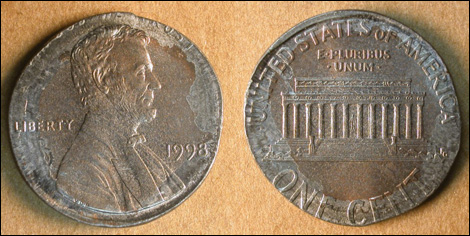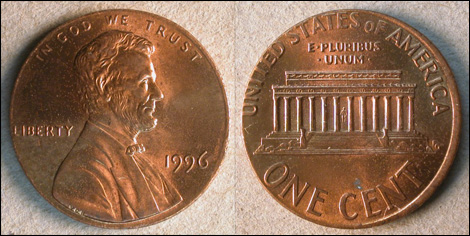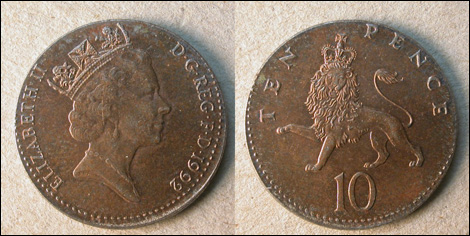 Wrong planchet/off-metal errors are always in demand, and doubly so if they are accompanied by another error.
Wrong planchet/off-metal errors are always in demand, and doubly so if they are accompanied by another error.
This 1998 cent was struck on an unplated, 2.05g zinc planchet apparently intended for another country (Figure 1). It undoubtedly got mixed in with the normal copper-plated zinc planchets supplied to the Mint by one of its outside contractors.
It does have a very light dusting of copper in the form of a “bulls eye” pattern in the center of each face, indicating that it should have ended up with a complete coating of copper. The edge of the coin is also slightly irregular.
It was originally labeled by ANACS as an “unplated elliptical clip”, but that diagnosis is clearly wrong. It doesn’t have an elliptical shape, there are no “points” located at opposite poles, and contact with the collar is limited to the southern pole.
U.S. cents struck on undersized copper-plated zinc planchets are well-known from the years 1996 – 2000. Their weights settle into a bimodal distribution, indicating the existence of two populations. The most common type is smaller in diameter and averages around 1.7 grams. The 1998 cent in Figure 2 is a representative of this population. It weighs 1.73 grams. The other type is larger and heavier, coming in at around 2.0 grams. The 1996 cent in Figure 3 is a representative example of this less common type. It weighs 2.07 grams. This specimen was struck on a copper-plated zinc blank (“Type I”). In other words, the blank either never went through the upset mill, or was sent through an upset mill intended for U.S. cent blanks. An undersized planchet wouldn’t betray any sign of having gone through an upset mill set up for a larger-diameter blank.
Since the weights are so similar, it’s reasonable to suppose that the unplated planchet belongs to the heavier population, but we can never be certain.
We still don’t know what countries the two types of copper-plated zinc planchets were originally intended for. Malaysia and Singapore have been suggested, but both guesses are untenable. A Malaysian 1 sen planchet is a poor candidate, as this coin is composed of copper-plated steel and sticks to a magnet. A Singapore cent planchet is also a non-starter as this copper-plated zinc coin is much smaller and lighter than either population, coming in at 1.24 grams. So if you see any U.S. cents encapsulated and labeled as having been struck on a Malaysian or Singapore planchet, ignore the attribution.
The 1998 cent in Figure 1 is not the only example of a coin struck on an unplated or incompletely plated foreign planchet. Figure 4 shows a 1992 British 10 pence struck on a steel planchet with a light and incomplete coating of copper on both faces. I don’t know what country the planchet was originally intended for.

Figure 1. A 1998 cent struck on an unplated zinc planchet intended for a foreign denomination. The lack of plating is an error.

Figure 2. A 1998 cent struck on a copper-plated zinc planchet intended for another country. It weighs 1.73 grams.

Figure 3. A 1996 cent struck on a copper-plated zinc blank that evidently was meant for a different country than the coin in Figure 2. It weighs 2.07 grams.

Figure 4. A 1992 British 10 pence struck on a steel planchet with a light and incomplete coating of copper.

